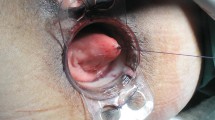Abstract.
There are doubts as to whether rectocele repair (RR) is beneficial for patients with concomitant anismus. The aim of this prospective study was to evaluate the effect of anismus on the clinical outcome of RR. In 71 out of 75 patients who underwent RR evacuation proctography (EP) was performed. Electromyography (EMG) of the pelvic floor and balloon expulsion test (BET) were carried out in 61 and 35 patients respectively. On EP, measuring the central anorectal angle (CARA) and the posterior anorectal angle (PARA), signs of anismus were found in 34 and 28 percent of the patients respectively. EMG and BET revealed anismus in 39 and 71 percent of the patients respectively. These results showed poor agreement. RR was successful in 53 (71%) out of 75 patients (follow up 14 – 74 months). No differences were found in clinical outcome in patients with and without signs of anismus. In conclusion, RR is beneficial for patients with obstructed defecation, and signs of anismus do not appear to be a contraindication for RR.
Résumé.
Il existe un doute quant à savoir si la cure chirurgicale d'une rectocèle (RR) est bénéfique pour des patients qui présentent simultanément un anisme. Le but de cette étude prospective est d'évaluer l'effet de l'anisme sur le résultat clinique des corrections chirurgicales des rectocèles. Des défécographies ont été réalisées chez 71 patients sur un total de 75 qui ont subi une cure chirurgicale de rectocèle. Une électromyographie du plancher pelvien et un test d'expulsion d'un ballonnet ont été réalisés chez respectivement 61 et 35 patients. Sur la défécographie, l'angle ano-rectal central a été mesuré ainsi que l'angle ano-rectal postérieur; des signes d'anisme ont été retrouvés respectivement chez 34 et 28 patients. L'électromyographie et le test d'expulsion du ballonnet ont démontré un anisme chez, respectivement, 39 et 71% des patients. Ces résultats montrent peu de concordance. La réparation de la rectocèle a été conduite avec succès chez 53 (71%) des 75 patients (un follow-up de 14 à 74 mois). Aucune différence n'a été retrouvée dans le devenir clinique chez les patients avec et sans signes d'anisme. En conclusion, la réparation d'une rectocèle est bénéfique chez des patients présentant une dyschésie, des signes d'anisme ne semblent pas être une contre-indication à la cure chirurgicale.
Similar content being viewed by others
Author information
Authors and Affiliations
Additional information
Accepted: 19 June 1996
Rights and permissions
About this article
Cite this article
van Dam, J., Schouten, W., Ginai, A. et al. The impact of anismus on the clinical outcome of rectocele repair. Int J Colorect Dis 11, 238–242 (1996). https://doi.org/10.1007/s003840050053
Issue Date:
DOI: https://doi.org/10.1007/s003840050053




